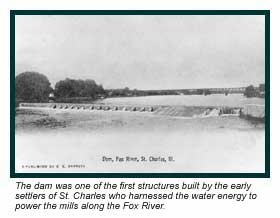In the summer of 1833, Evan Shelby and William Franklin moved west from Indiana and staked a claim on the east side of the Fox River just north of where Baker Park is today (Main Street and 4th Avenue). They left that winter and returned in the spring of 1834 with their families to purchase land from the government and build a cabin on their claim.
In 1834, Charleston was founded. Along with Evan Shelby and William and Lydia Franklin, many settlers bought land from the government and began to farm and improve the region. Included in this group were Dean and Read Ferson, Calvin Ward, Bela Hunt, and George and Ira Minard. These enterprising young men and women began to plot the town, establish the county, and sell land to new-coming settlers.
By the year 1836, construction was completed on the first dam, bridge, gristmill, and sawmill. The building of the dam was a crucial point in
the establishment of the town due to its role in the production of natural resources. Where a town would be built was dictated by the natural course of the river, or where ever the river allowed for an ideal spot for a dam. A dam provided water control which allowed for a water-powered mills to cut wood or grind flour, which was crucial to the growth of the town.
By 1837, Charleston had its share of masons, millwrights, builders, and even a doctor, lawyer, and potter. In addition, churches also sprang up with the growth of the town, including the Congregationalist, Baptist, Methodist, Catholic, and Universalists.
During the late 1830s, it was discovered that there was another Charleston in downstate Illinois. The southern Charleston was slightly older than the northern. In 1839, it was suggested by S.S. Jones, a lawyer in town, that the name of the town be changed from Charleston to St. Charles.
The first Main Street bridge over the Fox River was built in 1836. Between the days of March 11 and 12, 1839, a sleepy, ice-covered river turned into a raging torrent of water due to a sudden melting of snow. Consequently, every bridge in Kane County was swept away with the current. Many local people in St. Charles and the surrounding towns started private ferry services until new bridges were constructed.
There are competing stories of what happened to the bridge which replaced the original. One story claims it was again raging flood waters which washed the wooden timber bridge away, much like the fate of the first. Another story, however, tells the tale of an angry mob invading the town and permanently damaging the footbridge in the process. The raid was the Richards Riot that took place on April 19, 1849. In any case, the bridge was destroyed in April of 1849.
Once again, a new wooden timber bridge was built in place of the old, only to fall again to mother nature. In February 1857, the Fox River once again rose to a level that proved to be too much for the bridge. Learning from their first and second experiences, the settlers immediately constructed a temporary footbridge until a new bridge could be built. "Heavy wooden timbers" were used to reconstruct the bridge in 1857. However, being made of wood, the timbers were bound to rot, and rot they did until 1874 when the bridge was voluntarily replaced with iron.






